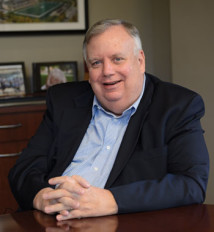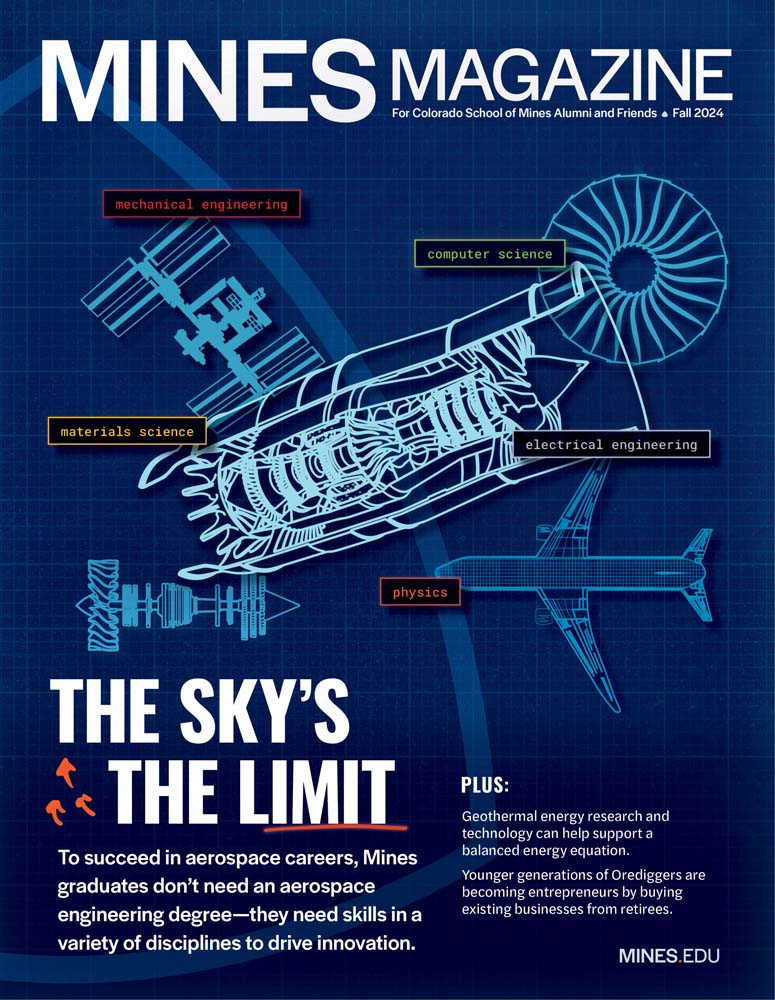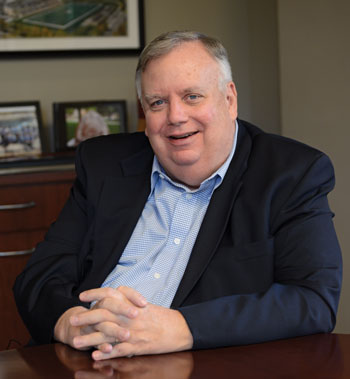 Seven years into his presidency, with plenty of milestones on record, a capital campaign in full swing, and some big changes on the horizon for Mines, we recently sat down with President Scoggins for an informal Q&A. Partly retrospection, partly introspection and partly forward-looking, the conversation that follows will be of interest to all those who support the growth and success of Mines, and are curious to learn more about its president.
Seven years into his presidency, with plenty of milestones on record, a capital campaign in full swing, and some big changes on the horizon for Mines, we recently sat down with President Scoggins for an informal Q&A. Partly retrospection, partly introspection and partly forward-looking, the conversation that follows will be of interest to all those who support the growth and success of Mines, and are curious to learn more about its president.
Mines: Nearly seven years ago, you transitioned from the corporate world to academia. What motivated your decision?
Scoggins: Not too long before I retired after more than 35 years in the oil and gas industry, I joined the board of trustees of my alma mater, the University of Tulsa. After I retired, I became increasingly active, serving on the executive committee and spending a great deal of time on campus. My wife and I both enjoyed the experience of being involved in the university. When I received the call from Mines asking me to consider being a candidate, I realized this was an opportunity to be part of a remarkable community.
Mines: What aspects of leading Mines do you find most rewarding?
Scoggins: The most rewarding moments revolve around students, seeing them be successful. I’m getting ready to participate in my 15th commencement, so I have had the opportunity to watch many wonderful students walk confidently across the stage, proud of their accomplishment, and poised to make great contributions to society. It’s very special to be a part of that.
I recently heard about an alumnus who is about to graduate from the University of Texas with master’s degrees in environmental engineering and public policy. At Mines, he was a lineman on the football team, and we got to know each other a little. Whenever he saw me on campus, he’d ask, “You gonna come to the game this weekend?” At his graduation, just before I handed him his diploma, I called out his jersey number and said, “James Tyree, #65, you did a hell of a job.” I got the biggest bear hug I think any president’s ever gotten during a college graduation ceremony.
Karen and I try to attend as many student activities as possible, from athletic events to plays and concerts, and we enjoy them all. I particularly enjoy the graduate research conference and looking at the students posters, even though I have to admit I really don’t understand all of them.
Really, the most rewarding aspect of my job is seeing the growth in our students over their time at Mines, which is a testament to their own hard work and to the dedication of the Mines faculty and staff who teach and interact with them.
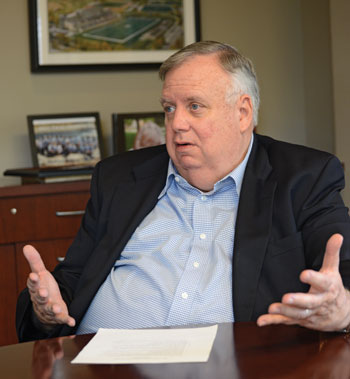 Mines: When you speak to individuals or groups less familiar with the university, how do you make the case for Mines? What does the university have to offer that sets it apart?
Mines: When you speak to individuals or groups less familiar with the university, how do you make the case for Mines? What does the university have to offer that sets it apart?
Scoggins: I talk about the focused nature of the school’s mission, the quality of the education our students receive, and the relevance of our research programs. Mines is uniquely positioned to deal with global challenges related to our focus areas of earth, energy and environment. These issues are at the forefront of the world’s most pressing concerns, and Mines is playing a critical role in educating students who will be leaders in addressing them through their careers and through meaningful research.
I also always point out something you will hear from almost every Mines alum and that I completely agree with, which is that our students develop a work ethic unlike almost any other university. By the time they graduate, our students truly have the skills to hit the ground running. They are a very special group.
Mines: The financial crisis erupted relatively early in your presidency. This must have posed some significant challenges.
Scoggins: When I interviewed for the position, the board of trustees indicated they wanted a lot of focus on the school’s financial condition. When I arrived, Mines was already in the process of putting together the all-funds budget. We tightened down our systems, controlled our costs and planned carefully. As a result, we have managed to weather some major cutbacks in state funding. We faced some financial challenges, but the school came through it with minimal adverse impacts.
Mines: In fact, you’ve overseen more building on campus than has taken place during any seven-year period in Mines history. How has this been possible? What has driven the expansion?
Scoggins: When I came to Mines in 2006, the school had recently finished a strategic plan and had been through a period of tremendous growth. It was clear that we had a significant shortage of academic infrastructure that had to be addressed immediately. We also needed to build the school’s residential capacity.
We faced a big challenge in financing these major building projects and used the full range of financing options available to us to make them possible. The students voted in favor of a capital fee that enabled us to expand Brown Hall. The state funded the Center for Technology and Learning Media expansion. We had private donors who funded Marquez Hall and the W. Lloyd Wright Student Wellness Center. We used our balance sheet to borrow money to allow us to construct the residence halls. We have made strides in catching up with our infrastructure needs, but we still have a long way to go when we look at current campus needs and where we see the school going in the next decade.
Mines: So what’s next, in terms of construction?
Scoggins: The Elm Hall residential and dining facility is under way, and the Welcome Center and privately funded Clear Creek Athletics Complex will all be under construction this year.
What’s next? We are discussing funding with private donors and the state of Colorado for a new cornerstone academic building to house physics and several other disciplines. The Green Center needs significant renovations. The library needs to be considered in our future planning, as well as a new research facility. And we anticipate continued growth in graduate enrollments, which may make another addition to Mines Park necessary. It’s a long list, with a big dollar commitment associated with it.
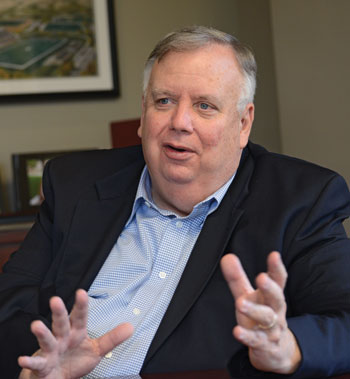 Mines: As we near the end of 2013, what do you believe are the top three strategic priorities for Mines?
Mines: As we near the end of 2013, what do you believe are the top three strategic priorities for Mines?
Scoggins: Over the last few years, we haven’t just increased the size of the student body; we’ve also raised the bar for admissions. Now we need to improve our retention and graduation rates. I want to see more of our students complete their degrees, so they can go on with their careers and lead successful lives. We are making progress, our freshmen-to-sophomore retention this fall was the best in decades, and I suspect that is because of the changes we’ve made to create a more supportive and diverse community environment, but I believe we can do better. Our top priority must be to improve student outcomes.
Second, we need to attract talented new faculty to join our remarkable and highly regarded corps of teaching and research professors. It takes a world-class faculty, in the classroom and the lab, to attract the best and the brightest students and provide a first-class education. One way we’ll achieve this is by encouraging continued growth in our research programs. Funding in this area has tripled in recent years, bringing with it great opportunities for faculty and students.
Third, we must continue to improve the school’s financial position so we have the flexibility and agility to take advantage of opportunities and implement our vision. The financial model for public higher education has changed, probably forever. It’s unlikely that there will be a significant influx of state funding, so we must forge our own path forward with value-based tuition revenue, a solid balance sheet to enable us to prudently borrow funds when needed, and a robust endowment and annual gifts to sustain the university.
Mines: How will the Transforming Lives campaign help address these priorities?
Scoggins: The campaign goals and our institutional priorities line up almost exactly one to one. Student outcomes are enhanced when we have financial aid resources to provide scholarships and fellowships, and to support undergraduate and graduate research programs. Creating new endowed chairs and professorships strengthens our faculty. Gifts to capital projects enable us to move forward in creating an infrastructure that matches our world-class programs.
Mines: How are the goals of this campaign different from Mines’ past campaigns?
Scoggins: The financial goal, $350 million, is substantially higher than past campaigns. Many of the areas we’re focused on student support, faculty support and capital needs are similar. We will still be relying on the support of our broad alumni base, the corporations that have historically supported us, and donors who are friends of the school. But we will also be reaching out to new potential individual and corporate donors to broaden our base of support.
Mines: The job of leading a university is a serious one, but there must be some humorous moments along the way. Does one in particular come to mind?
Scoggins: The first semester I was here, close to December graduation, Karen and I were walking to a basketball game on a Saturday night when I looked up at the M. But instead of an M, I saw a lowercase b, and immediately thought some students from Boulder had pulled a prank.
I called public safety (which on the weekend rolls over to the Golden Police), identified myself as president of the school and explained my concern. After the dispatcher said they would check on it, we went into the game and sat down next to two alums. I asked if they’d seen the b on the M. They looked at each other, grinned and said, “Has no one told you about the countdown to graduation? That’s a 6, not a b.”
When I called Golden Police back, I could hear laughing in the background. The dispatcher said, “Well, President Scoggins, whatever you do, don’t leave the building until we call off the SWAT teams.” They were just dying laughing.
Mines: Is there anything you’d like to say that we haven’t asked you about?
Scoggins: We’ve talked about adding new buildings to campus, and expanding our faculty and graduate enrollments, but I want to make it clear that while we’ve enjoyed significant enrollment growth in the last few years, we recognize the value of our relatively small size. Future growth is going to be carefully managed.
We also talked about the importance of the campaign to the university. I’m not sure I adequately conveyed the depth of my appreciation to the alumni and friends who have always been there to support us. There are folks out there I can call and say, ‘We need your help, and they can always be relied upon to support the school.’ I’d like to be able to say, ‘This is the last time I’m ever going to call and ask for your help,’ but it won’t be. I just want all our loyal friends and supporters to know how very important they are to Mines.

